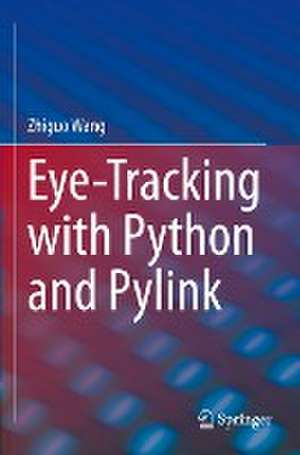Eye-Tracking with Python and Pylink
Autor Zhiguo Wangen Limba Engleză Paperback – 28 noi 2022
Eye-tracking is a widely used research technique in psychology and neuroscience labs. Research grade eye-trackers are typically faster, more accurate, and of course, more expensive than the ones seen in consumer goods or usability labs. Not surprisingly, a successful eye-tracking study usually requires sophisticated computer programming. Easy syntax and flexibility make Python a perfect choice for this task, especially for psychology researchers with little or no computer programming experience.
This book offers detailed coverage of the Pylink library, a Python interface for the gold standard EyeLink ® eye-trackers, with many step-by-step example scripts. This book is a useful reference for eye-tracking researchers, but you can also use it as a textbook for graduate-level programming courses.
| Toate formatele și edițiile | Preț | Express |
|---|---|---|
| Paperback (1) | 581.33 lei 6-8 săpt. | |
| Springer International Publishing – 28 noi 2022 | 581.33 lei 6-8 săpt. | |
| Hardback (1) | 730.16 lei 6-8 săpt. | |
| Springer International Publishing – 27 noi 2021 | 730.16 lei 6-8 săpt. |
Preț: 581.33 lei
Preț vechi: 683.92 lei
-15% Nou
Puncte Express: 872
Preț estimativ în valută:
111.24€ • 116.43$ • 92.58£
111.24€ • 116.43$ • 92.58£
Carte tipărită la comandă
Livrare economică 31 martie-14 aprilie
Preluare comenzi: 021 569.72.76
Specificații
ISBN-13: 9783030826376
ISBN-10: 3030826376
Pagini: 233
Ilustrații: X, 233 p. 41 illus., 34 illus. in color.
Dimensiuni: 155 x 235 mm
Greutate: 0.35 kg
Ediția:1st ed. 2021
Editura: Springer International Publishing
Colecția Springer
Locul publicării:Cham, Switzerland
ISBN-10: 3030826376
Pagini: 233
Ilustrații: X, 233 p. 41 illus., 34 illus. in color.
Dimensiuni: 155 x 235 mm
Greutate: 0.35 kg
Ediția:1st ed. 2021
Editura: Springer International Publishing
Colecția Springer
Locul publicării:Cham, Switzerland
Cuprins
Preface; Chapter 1.- A gentle introduction to Python; Chapter 2.- Building experiments with PsychoPy; Chapter 3.- Building experiments with Pygame; Chapter 4.- Getting to know Pylink; Chapter 5.- Preparing scripts for analysis and visualization in Data Viewer; Chapter 6.- Retrieving gaze data over the link; Chapter 7.- Advanced Pylink Functions; Chapter 8:Data analysis and visualization in Python; Chapter 9.- Miscellaneous.
Notă biografică
Dr. Zhiguo Wang is a research professor at Zhejiang University. He received his Ph.D. from the Graduate University of Chinese Academy of Sciences and had his post-doctoral training at Vrije Universiteit (the Netherlands) and Macquarie University (Australia). He was a senior scientist at SR Research Ltd. (Canada) before joining the Center for Psychological Sciences at Zhejiang University.
Dr. Zhiguo Wang was a recipient of the prestigious Australian Research Council Discovery Early Career Researcher Award. His current research work focuses on issues in engineering psychology, but he is also interested in research topics in vision, eye movements, visual working memory, spatial attention, and developmental disorders
Dr. Zhiguo Wang was a recipient of the prestigious Australian Research Council Discovery Early Career Researcher Award. His current research work focuses on issues in engineering psychology, but he is also interested in research topics in vision, eye movements, visual working memory, spatial attention, and developmental disorders
Textul de pe ultima copertă
Several Python programming books feature tools designed for experimental psychologists. What sets this book apart is its focus on eye-tracking.
Eye-tracking is a widely used research technique in psychology and neuroscience labs. Research grade eye-trackers are typically faster, more accurate, and of course, more expensive than the ones seen in consumer goods or usability labs. Not surprisingly, a successful eye-tracking study usually requires sophisticated computer programming. Easy syntax and flexibility make Python a perfect choice for this task, especially for psychology researchers with little or no computer programming experience.
This book offers detailed coverage of the Pylink library, a Python interface for the gold standard EyeLink ® eye-trackers, with many step-by-step example scripts. This book is a useful reference for eye-tracking researchers, but you can also use it as a textbook for graduate-level programming courses.
Eye-tracking is a widely used research technique in psychology and neuroscience labs. Research grade eye-trackers are typically faster, more accurate, and of course, more expensive than the ones seen in consumer goods or usability labs. Not surprisingly, a successful eye-tracking study usually requires sophisticated computer programming. Easy syntax and flexibility make Python a perfect choice for this task, especially for psychology researchers with little or no computer programming experience.
This book offers detailed coverage of the Pylink library, a Python interface for the gold standard EyeLink ® eye-trackers, with many step-by-step example scripts. This book is a useful reference for eye-tracking researchers, but you can also use it as a textbook for graduate-level programming courses.
Caracteristici
Detailed coverage of the Python interface for the gold standard EyeLink eye-trackers Many step-by-step example scripts help the reader to learn quickly A chapter on eye movement data processing and visualization
